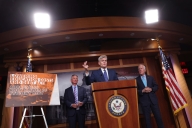You have /5 articles left.
Sign up for a free account or log in.
Colleges’ attempts to curb employee costs by hiring part-time faculty members and using grad students are being offset by administrative hires and rising benefit costs, according to a new study by the Delta Cost Project at the American Institutes for Research.
The study uses federal data to examine hiring trends going back to 1990. Over all, it found, colleges have hired at a faster pace from 2000 to now than they did in the 1990s, but that tempo didn’t do enough to keep up with an influx of millennials and other students who flocked to colleges amid the recession.
The changes highlighted in the study may seem somewhat marginal at an institutional level – the work force increases and decreases amounted to no more than a couple handfuls of employees per 1,000 students – but across the vastness of higher ed, they help explain the current employment landscape.
Public research universities and community colleges had on average about 16 fewer employees per 1,000 students in 2012 than in 2000. Private institutions, which cannot rely on economies of scale, had 15 to 26 more workers per 1,000 students. The ratio of employees to students at public master’s and bachelor’s colleges remained unchanged.
In a finding that could interest consumers, policy makers and unions, the report argues that salaries for full-time faculty did little to drive up the prices students and families paid.
“Faculty salaries were not the leading cause of rising college tuitions during the past decade,” the report says. “Increased benefits costs, nonfaculty positions added elsewhere on campus, declines in state and institutional subsidies, and other factors all played a role.”
Salaries for full-time faculty remained essentially flat, although full-time benefits rose discernibly, as did other employee costs.
At public research universities, for instance, full-time faculty salaries went up barely 0.2 percent per year on average from 2000 to 2012, but full-time faculty benefits increased 2 percent per year.
At the same time, the average salary for a full-time-equivalent employee of any kind – not just full-time faculty – went up by 1.2 percent per year, and benefits increased by 4.2 percent per year.
Donna Desrochers, one of the report’s authors, said this suggests that efforts to hold down expenses for full-time faculty members were being undercut by other decisions about campus personnel.
“If you’re hiring all these adjuncts at $3,000 per course, you would expect your average salary outlay to be going down, and it’s not,” she said.
At least half of all instructional positions are now filled by part-time instructors or graduate students. Some colleges are using the part-timers differently from others. At well-funded research universities and private colleges, part-time faculty members are helping provide additional capacity. But at broadly accessible public master’s and bachelor’s colleges, the part timers are actually replacing full-time positions.
“Public master’s and bachelor’s colleges lost between two and four full-time faculty per 1,000 FTE students from 2000 to 2012, mirroring the increase in ‘full-time equivalent’ part-time faculty,” the report says.
The report also looked at the growth in administrative positions, which have become the target for criticism.
It found that while administrative growth has been widespread, “professional positions” grew faster than executive and management jobs. And among those non-management jobs, the largest growth was in what the authors categorized as “student support” jobs – including career counseling, financial aid and athletics – rather than business support roles.




